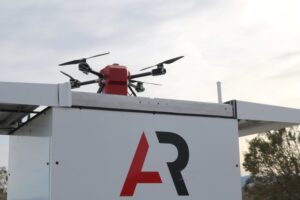
Commercial drone provider American Robotics this week flew into rarified skies, becoming the first company approved by the FAA to operate automated drones without human operators on-site.
The authorization allows American Robotics to deploy its Scout drone system with acoustic Detect-and-Avoid (DAA) technology that enables drones to maintain a safe distance from other aircraft.
Company officials say its drone-based aerial intelligence platform will be able to operate safely in the National Airspace System (NAS), even when it conducts flights Beyond-Visual-Line-of-Sight (BVLOS) of the operator.
Each Scout drone “lives” within a weatherproof base station which enables autonomous charging, data processing and analysis at the edge, and data transmission. Once installed in the field, all facets of Scout’s operation are automated, unleashing the drones to gather and analyze ultra-high-resolution data multiple times per day for multiple years without human interference.
The Scout System consists of three primary components:
- Scout – an autonomous, AI-powered unmanned aircraft with advanced imaging payloads.
- ScoutBase – a weatherproof base station that serves as the nerve center and communication hub for Scout. ScoutBase autonomously houses and charges Scout, processes the raw data collected on each flight, and transmits the analyzed information to American Robotics’ cloud-based data centers.
- ScoutView – a secure web portal and API which enables remote interaction with the system, data, and resulting analytics anywhere in the world.
“With these approvals, American Robotics is ushering in a new era of widespread automated drone operations,” said Reese Mozer, CEO and co-founder of American Robotics.
“Decades worth of promise and projection are finally coming to fruition. We are proud to be the first company to meet the FAA’s comprehensive safety requirements, which had previously restricted the viability of drone use in the commercial sector. We are very grateful for the FAA’s willingness to work closely with American Robotics over the past four years on this precedent-setting authorization. With this set of approvals, American Robotics can begin safely operating our automated Scout platform for the benefit of the energy, infrastructure, agriculture, and security market verticals, helping unlock the projected $100 billion commercial drone market.”
Lisa Ellman, Partner and Chair of the Global UAS Practice at Hogan Lovells, and Executive Director of the Commercial Drone Alliance added: “The commercial drone industry is growing quickly and providing significant benefits to the American public but enabling expanded operations beyond visual line of sight is critical for the industry to truly take off.”
“Automated BVLOS operations are particularly important to opening the commercial sectors to the drone economy, including the agriculture and industrial verticals. Key to these operations is the use and FAA acceptance of new and innovative safety technologies, such as detect and avoid (DAA) sensors and software-enabled automation. American Robotics’ groundbreaking and exciting FAA approval is an important and significant step forward for the commercial drone community as a whole.”
Jason is a longstanding contributor to DroneLife with an avid interest in all things tech. He focuses on anti-drone technologies and the public safety sector; police, fire, and search and rescue.
Beginning his career as a journalist in 1996, Jason has since written and edited thousands of engaging news articles, blog posts, press releases and online content.
Email Jason
TWITTER:@JasonPReagan
Subscribe to DroneLife here.







[…] more at Dronelife with this link, at JD Supra about their exemption here, as covered by Commercial UAV News here and a SlashGear […]